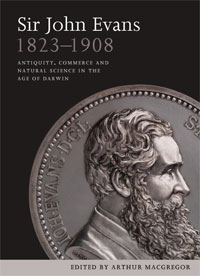Part I: Introduction |
| Chapter One |
Sir John Evans, model Victorian, polymath and collector (Arthur MacGregor) |
| Chapter Two |
The business foundation for a public career: Evans, the paper industry and life at Nash Mills (Jill Penwarden and Michael Stanyon) |
| |
|
Part II: Scientist and Archaeologist |
| Chapter Three |
Evans, geology and palaeontology (Patrick J. Boylan) |
| Chapter Four |
The Hydrogeological work of Sir John Evans: his role in the battle between geologists and engineers for the water of the Chilterns (J.D. Mather) |
| Chapter Five |
Reading the unwritten history: Evans and Ancient Stone Implements (Alison Roberts and Nick Barton) |
| Chapter Six |
'Au silence et au travail': Evans and the Bronze Age (Brendon O'Connor) |
| Chapter Seven |
Evans and antiquities from the Roman to the post-medieval period (Arthur MacGregor) |
| |
|
Part III: Numismatist |
| Chapter Eight |
Evans and ancient British coins (Philip de Jersey) |
| Chapter Nine |
Evans and the Roman coinage (Cathy King) |
| Chapter Ten |
Evans and the English coinage (Lord Stewartby) |
| |
|
Part IV: Crossing Borders, Crossing Disciplines |
| Chapter Eleven |
A significant friendship: Evans, Lubbock and a Darwinian world order (Janet Owen) |
| Chapter Twelve |
Evans, Scandinavia and international exchange networks (Susanne Bangert) |
| Chapter Thirteen |
Evans's sketches from the human antiquity controversy: epistemological proxies in the making (Assimina Kaniari) |
| |
|
Part V: Appendices |
| Appendix I |
Nash Mills from the Hertfordshire Standard and St. Albans Citizen, 1891 |
| Appendix II |
Bibliography of the works of Sir John Evans |
| Appendix III |
The Sir John Evans Centenary Project at the Ashmolean Museum |


